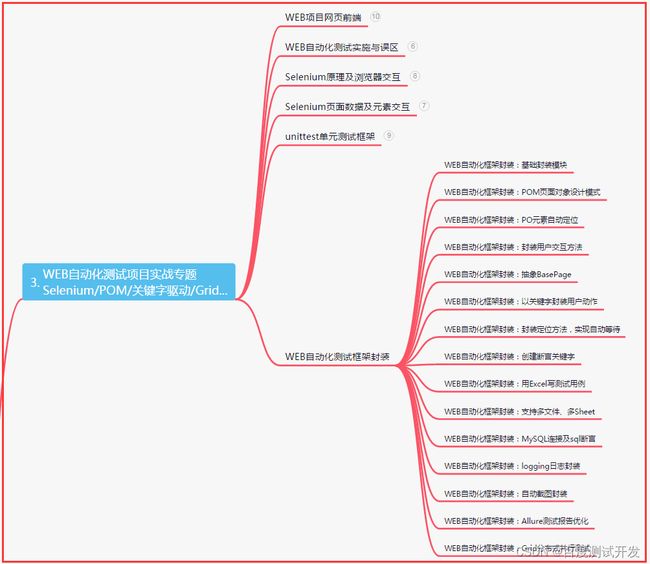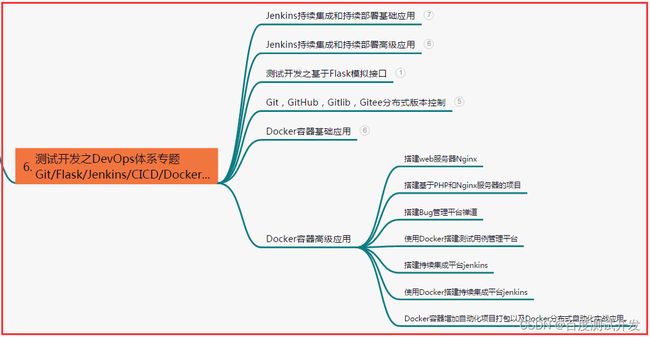全网最全,Pytest自动化测试框架-前后置操作详细,一篇带你通关...
目录:导读
-
- 前言
- 一、Python编程入门到精通
- 二、接口自动化项目实战
- 三、Web自动化项目实战
- 四、App自动化项目实战
- 五、一线大厂简历
- 六、测试开发DevOps体系
- 七、常用自动化测试工具
- 八、JMeter性能测试
- 九、总结(尾部小惊喜)
前言
1、Pytest 的前置与后置处理
Pytest贴心的提供了类似setup、teardown的方法,并且还超过四个,一共有十种
模块级别:setup_module、teardown_module;
函数级别:setup_function、teardown_function,不在类中的方法;
类级别:setup_class、teardown_class;
方法级别:setup_method、teardown_method;
方法细化级别:setup、teardown;
2、setup和teardown的详细使用
代码:
#!/usr/bin/env python
# -*- coding: utf-8 -*-
import pytest
def setup_module():
print("=====整个.py模块开始前只执行一次:登录=====")
def teardown_module():
print("=====整个.py模块结束后只执行一次:数据清理=====")
def setup_function():
print("===每个函数级别用例开始前都执行setup_function===")
def teardown_function():
print("===每个函数级别用例结束后都执行teardown_function====")
def test_one():
print("1")
def test_two():
print("2")
class TestCase():
def setup_class(self):
print("====整个测试类开始前只执行一次setup_class====")
def teardown_class(self):
print("====整个测试类结束后只执行一次teardown_class====")
def setup_method(self):
print("==测试类里面每个用例执行前都会执行setup_method==")
def teardown_method(self):
print("==测试类里面每个用例结束后都会执行teardown_method==")
def setup(self):
print("=测试类里面每个用例执行前都会执行setup=")
def teardown(self):
print("=测试类里面每个用例结束后都会执行teardown=")
def test_three(self):
print("3")
def test_four(self):
print("4")
if __name__ == '__main__':
pytest.main(["-q", "-s", "-ra", "testc.py"])
运行结果:
C:\Users\chenyongzhi11\.virtualenvs\api-test-project-FfYYNBU1\Scripts\python.exe D:/apk_api/api-test-project/debug/debug_pytest.py
=====整个.py模块开始前只执行一次:登录=====
===每个函数级别用例开始前都执行setup_function===
1
.===每个函数级别用例结束后都执行teardown_function====
===每个函数级别用例开始前都执行setup_function===
2
.===每个函数级别用例结束后都执行teardown_function====
====整个测试类开始前只执行一次setup_class====
==测试类里面每个用例执行前都会执行setup_method==
3
.==测试类里面每个用例结束后都会执行teardown_method==
==测试类里面每个用例执行前都会执行setup_method==
4
.==测试类里面每个用例结束后都会执行teardown_method==
====整个测试类结束后只执行一次teardown_class====
=====整个.py模块结束后只执行一次:数据清理=====
4 passed in 0.33s
进程已结束,退出代码0
模块级别:模块级别的初始化、清除分别再整个模块的测试用例执行钱后执行,并且只执行一次
类级别:类级别的初始化、清除分别再整个类的测试用例执行前后执行,并且只执行一次
方法级别:方法级别的初始化、清除分别在类的每个测试方法执行前后执行,并且每个用例执行一次
注意:上述都是针对整个脚本全局生效
3、Fixture的详细使用
1)fixture的优势
名命灵活,不局限与setup\teardown 的名命
conftest.py 配置可以实现数据共享,不需要import 就能自动找到fixture
scope=“module” 实现多py文件共享前置
scope=“session” 实现多个py文件使用一个session完成多用例
2)fixture参数列表
@pytest.fixture(scope="function", params=None, autouse=False, ids=None, name=None)
def test():
print("fixture初始化的参数列表")
参数列表
scope:可以理解成fixture的作用域,默认:function,还有class、module、package、session四个【常用】
autouse:默认:False,需要用例手动调用该fixture;如果是True,所有作用域内的测试用例都会自动调用该fixture
name:默认:装饰器的名称,同一模块的fixture相互调用建议写个不同的name
注意:session的作用域:是整个测试会话,即开始执行pytest到结束测试
3)测试用例调用fixture的方式
将fixture名称作为测试用例函数的输入参数
方式1:
测试用例加上装饰器:@pytest.mark.usefixtures(fixture_name)
fixture设置autouse=True
将fixture名称作为测试用例函数的输入参数
import pytest
# 调用方式一
@pytest.fixture
def login():
print("输入账号,密码先登录")
def test_s1(login):
print("用例 1:登录之后其它动作 111")
def test_s2(): # 不传 login
print("用例 2:不需要登录,操作 222")
if __name__ == '__main__':
pytest.main(["-s", 'debug_pytest.py'])
结果:
============================= test session starts =============================
platform win32 -- Python 3.9.5, pytest-7.3.1, pluggy-1.0.0
rootdir: D:\apk_api\api-test-project\debug
plugins: Faker-18.4.0
collected 2 items
debug_pytest.py 输入账号,密码先登录
用例 1:登录之后其它动作 111
.用例 2:不需要登录,操作 222
.
============================== 2 passed in 0.14s ==============================
进程已结束,退出代码0
方式2:
测试用例加上装饰器:@pytest.mark.usefixtures(fixture_name)
import pytest
# 调用方式一
@pytest.fixture
def login():
print("输入账号,密码先登录")
# 调用方式二
@pytest.fixture
def login2():
print("please输入账号,密码先登录")
@pytest.mark.usefixtures("login2", "login")
def test_s11():
print("用例 11:登录之后其它动作 111")
注意:
在类声明上面加 @pytest.mark.usefixtures() ,代表这个类里面所有测试用例都会调用该fixture
可以叠加多个 @pytest.mark.usefixtures() ,先执行的放底层,后执行的放上层
可以传多个fixture参数,先执行的放前面,后执行的放后面
如果fixture有返回值,用 @pytest.mark.usefixtures() 是无法获取到返回值的,必须用传参的方式(方式一)
方式3:
fixture设置autouse=True
import pytest
# 调用方式三
@pytest.fixture(autouse=True)
def login3():
print("====所有作用域内的测试用例都会自动调用该fixture===")
def test_s1(login3):
print("用例 1:登录之后其它动作 111")
def test_s2(): # 不传 login
print("用例 2:不需要登录,操作 222")
# 不是test开头,加了装饰器也不会执行fixture
@pytest.mark.usefixtures("login3")
def loginss():
print(123)
4、fixture的实例化顺序
较高 scope 范围的fixture(session)在较低 scope 范围的fixture( function 、 class )之前实例化【session > package > module > class > function】
具有相同作用域的fixture遵循测试函数中声明的顺序,并遵循fixture之间的依赖关系【在fixture_A里面依赖的fixture_B优先实例化,然后到fixture_A实例化】
自动使用(autouse=True)的fixture将在显式使用(传参或装饰器)的fixture之前实例化
import pytest
order = []
@pytest.fixture(scope="session")
def s1():
order.append("s1")
@pytest.fixture(scope="module")
def m1():
order.append("m1")
@pytest.fixture
def f1(f3, a1):
# 先实例化f3, 再实例化a1, 最后实例化f1
order.append("f1")
assert f3 == 123
@pytest.fixture
def f3():
order.append("f3")
a = 123
yield a
@pytest.fixture
def a1():
order.append("a1")
@pytest.fixture
def f2():
order.append("f2")
def test_order(f1, m1, f2, s1):
# m1、s1在f1后,但因为scope范围大,所以会优先实例化
assert order == ["s1", "m1", "f3", "a1", "f1", "f2"]
执行结果:断言成功
关于fixture的注意点
添加了 @pytest.fixture ,如果fixture还想依赖其他fixture,需要用函数传参的方式,不能用 @pytest.mark.usefixtures() 的方式,否则会不生效
@pytest.fixture(scope="session")
def open():
print("===打开浏览器===")
@pytest.fixture
# @pytest.mark.usefixtures("open") 不可取!!!不生效!!!
def login(open):
# 方法级别前置操作setup
print(f"输入账号,密码先登录{open}")
5、fixture的后置teardown
用fixture实现teardown并不是一个独立的函数,而是用 yield 关键字来开启teardown操作(yield 之前是前置,之后是后置)
import pytest
@pytest.fixture(scope="session")
def open():
# 会话前置操作setup
print("===打开浏览器===")
test = "测试变量是否返回"
yield test
# 会话后置操作teardown
print("==关闭浏览器==")
@pytest.fixture
def login(open):
# 方法级别前置操作setup
print(f"输入账号,密码先登录---{open}")
name = "==我是账号=="
pwd = "==我是密码=="
age = "==我是年龄=="
# 返回变量
yield name, pwd, age
# 方法级别后置操作teardown
print("登录成功")
def test_s2(login):
print("==用例2==")
print(login)
yield注意事项:
如果yield前面的代码,即setup部分已经抛出异常了,则不会执行yield后面的teardown内容
如果测试用例抛出异常,yield后面的teardown内容还是会正常执行
6、addfinalizer
在用法上,addfinalizer跟yield是不同的,需要你去注册作为终结器使用的函数。
import pytest
@pytest.fixture()
def demo_fixture(request):
print("\n这个fixture在每个case前执行一次")
def demo_finalizer():
print("\n在每个case完成后执行的teardown")
# 注册demo_finalizer为终结函数
request.addfinalizer(demo_finalizer)
def test_01(demo_fixture):
print("\n===执行了case: test_01===")
def test_02(demo_fixture):
print("\n===执行了case: test_02===")
def test_03(demo_fixture):
print("\n===执行了case: test_03===")
7、yield与addfinalizer的区别
1)addfinalizer可以注册多个终结函数。
import pytest
@pytest.fixture()
def demo_fixture(request):
print("\n这个fixture在每个case前执行一次")
def demo_finalizer():
print("\n在每个case完成后执行的teardown")
def demo_finalizer2():
print("\n在每个case完成后执行的teardown2")
def demo_finalizer3():
print("\n在每个case完成后执行的teardown3")
# 注册demo_finalizer为终结函数
request.addfinalizer(demo_finalizer)
request.addfinalizer(demo_finalizer2)
request.addfinalizer(demo_finalizer3)
def test_01(demo_fixture):
print("\n===执行了case: test_01===")
def test_02(demo_fixture):
print("\n===执行了case: test_02===")
def test_03(demo_fixture):
print("\n===执行了case: test_03===")
2)当setUp的代码执行错误,addfinalizer依旧会执行
conftest.py的详细讲解
可以理解成一个专门存放fixture的配置文件,如果多个测试用例文件(test_*.py)的所有用例都需要用登录功能来作为前置操作,那就不能把登录功能写到某个用例文件中去了,conftest.py的出现,就是为了解决上述问题,单独管理一些全局的fixture。
conftest.py配置fixture注意事项:
pytest会默认读取conftest.py里面的所有fixture;
conftest.py 文件名称是固定的,不能改动;
conftest.py只对同一个package下的所有测试用例生效;
不同目录可以有自己的conftest.py,一个项目中可以有多个conftest.py;
测试用例文件中不需要手动import conftest.py,pytest会自动查找;
conftest.py使用举例
conftest.py文件(scope=“session”)
import pytest
@pytest.fixture(scope="session")
def login():
print("输入账号密码")
yield
print("清理数据完成")
case文件:
import pytest
class TestLogin1():
def test_1(self, login):
print("用例1")
def test_2(self):
print("用例2")
def test_3(self, login):
print("用例3")
if __name__ == '__main__':
pytest.main()
输出:
输入账号密码
PASSED [ 33%]用例1
PASSED [ 66%]用例2
PASSED [100%]用例3
清理数据完成
可以看出,conftest.py内的fixture方法的作用范围是session,调用时,整个.py文件只会调用一次
conftest.py注意事项:
conftest.py的作用域与Python变量作用域相同;
内层包内conftest.py不允许被其它包的测试类或方法使用,相当于本地变量;
外层conftest.py可被内层测试类和方法使用,相当于全局变量;
| 下面是我整理的2023年最全的软件测试工程师学习知识架构体系图 |
一、Python编程入门到精通
二、接口自动化项目实战
三、Web自动化项目实战
四、App自动化项目实战
五、一线大厂简历
六、测试开发DevOps体系
七、常用自动化测试工具
八、JMeter性能测试
九、总结(尾部小惊喜)
不论面对何种困难,都要保持乐观积极的态度。生活就像一面镜子,你对它笑,它也会对你笑。相信自己的力量,勇往直前,成功就在不远处等待着你。
不论面对何种困难,都要保持乐观积极的态度。生活就像一面镜子,你对它笑,它也会对你笑。相信自己的力量,勇往直前,成功就在不远处等待着你。
在这个世界上,唯一不变的就是变化本身。无论遇到什么挑战,都要勇于适应、敢于创新,这样你才能抓住机遇,在不断前进中取得成功。







